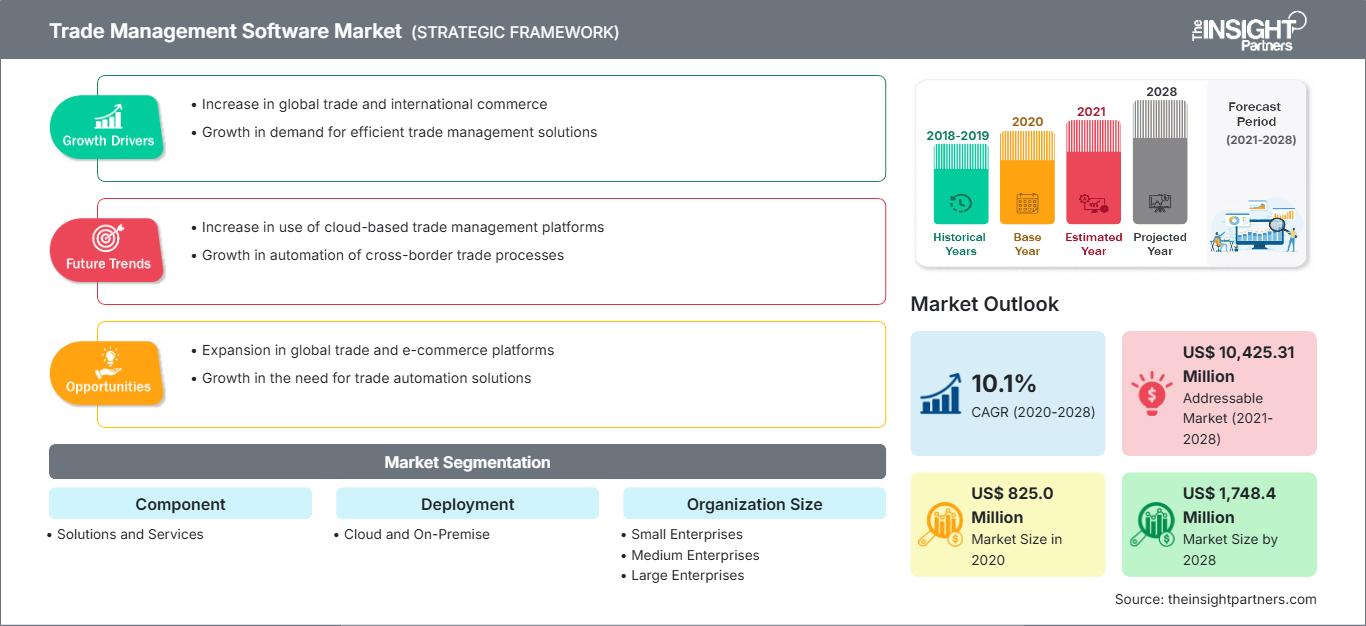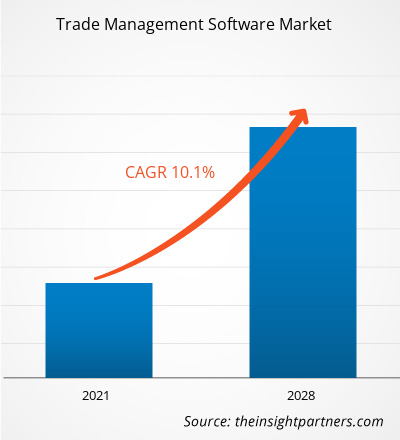[調査レポート]収益の面では、世界の貿易管理ソフトウェア市場は2020年に8億2,500万米ドルと評価され、2028年までに17億4,840万米ドルに達すると予測されています。また、2020年から2028年の予測期間中、年平均成長率(CAGR)10.1%で成長すると見込まれています。
貿易管理ソフトウェア市場は、北米、ヨーロッパ、アジア太平洋地域、中東およびアフリカ(MEA)、およびサモア(SAM)の5つの主要地域に大別されます。2020年の貿易管理ソフトウェア市場はAPAC地域が牽引しました。APACには、それぞれの製造業で高い成長を遂げている多くの発展途上国があり、世界的な製造業の中心地となっています。中国や、インド、韓国、台湾、ベトナムなどの他の発展途上国では、多くの企業が低技能から中技能の製造施設をより低コストの労働力を持つ近隣諸国に移転しています。さらに、これらの国の政府は、この地域への外国投資を改善するための開発を行っています。長年にわたり、この地域の製造業の支出は大幅に増加しており、今後もまともな成長率で成長すると予想されています。製造業の支出の劇的な増加と新しい技術の採用は、この地域の貿易管理ソフトウェアの需要を促進する主な要因です。
貿易管理ソフトウェア市場へのCOVID-19パンデミックの影響
COVID-19パンデミックは、2019年12月以来、世界中のあらゆるビジネスに影響を及ぼしています。ウイルスに感染した患者の数が継続的に増加しているため、政府は人や物の輸送を制限せざるを得ませんでした。製造業は、一時的な工場の閉鎖と生産量の低下により深刻な損失を被り、小売、電子商取引、物流部門の成長を妨げました。さらに、政府によって課された社会的または物理的な距離を置く措置は、物流やその他のサービスプロバイダーの業務に制限を課しています。この混乱は貿易ビジネスの衰退をもたらしました。これらの逆境により、2020年5月の世界貿易量は2019年5月と比較して17.7%減少しました。2020年の最初の5か月間の減少は広範囲に及びましたが、特に日本、米国、欧州諸国からの輸出に大きな影響を及ぼしました。COVID-19パンデミックによる混乱にもかかわらず、長いロックダウン後のビジネス再開に伴い、今後貿易は急増すると予想されます。ソーシャルディスタンス対策が実施される中、eコマース、物流、小売など、貿易活動に関わるセクターは、サプライチェーンのスピードを確保することでコンプライアンスを満たすため、貿易管理ソフトウェアの導入に注力しています。このように、COVID-19によってもたらされた不確実性は、物流におけるクラウドベースのソフトウェア/SaaSの活用範囲を拡大しました。
要件に合わせてレポートをカスタマイズ
レポートの一部、国レベルの分析、Excelデータパックなどを含め、スタートアップ&大学向けに特別オファーや割引もご利用いただけます(無償)
貿易管理ソフトウェア市場: 戦略的洞察

- このレポートの主要な市場動向を入手してください。この無料サンプルには、市場動向から見積もりや予測に至るまでのデータ分析が含まれます。
市場洞察 - 貿易管理ソフトウェア市場のコスト削減とリアルタイムの可視性
レポートの一部、国レベルの分析、Excelデータパックなどを含め、スタートアップ&大学向けに特別オファーや割引もご利用いただけます(無償)
貿易管理ソフトウェア市場: 戦略的洞察

- このレポートの主要な市場動向を入手してください。この無料サンプルには、市場動向から見積もりや予測に至るまでのデータ分析が含まれます。
貿易は、サプライヤー、運送業者、倉庫のネットワークを介した複数の商品と情報の流れを伴う複雑なプロセスです。ソフトウェアソリューションは、リアルタイムおよび現実世界のデータの分析を通じて、ユーザーがこれらの複雑なプロセスをより正確かつ容易に処理できるように支援し、非効率性を削減します。これらのソフトウェアシステムの導入は、サプライチェーンの機能を向上させ、業務のリアルタイムの可視性も提供します。様々な業界における競争力の高まりは、自動化とデジタル化への投資を促す大きな要因となっています。さらに、クラウドベースのソリューションの導入は、輸出品のリアルタイムの可視性を向上させ、運用コストを削減します。ブロックチェーン、人工知能(AI)、予測分析などの新興技術を物流業務に導入することで、今後数年間で世界の貿易管理ソフトウェア市場の成長をさらに促進するでしょう。
コンポーネントセグメントの洞察
コンポーネントに基づいて、貿易管理ソフトウェア市場はソリューションとサービスに分類されます。予測期間中、ソリューションセグメントは世界の貿易管理ソフトウェア市場をリードするセグメントになると予想されています。ソリューションセグメントには、貿易コンプライアンスと国際貿易の可視性と実行が含まれます。さらに、国際貿易の可視性と実行業務には、国境を越えた輸送も含まれます。これらの業務は、国際貿易パートナーのイベントやプロセスの可視性を提供します。これらのプロセスは国際的である必要があり、商業貿易パートナー間の取引や契約が含まれます。
導入セグメントの洞察
導入に基づいて、貿易管理ソフトウェア市場はオンプレミスとクラウドに分類されます。予測期間中、クラウドセグメントは世界の貿易管理ソフトウェア市場をリードするセグメントになると予想されます。クラウド導入は主に中小企業で採用されています。低い所有コスト、保守・アップグレードコストの削減、最新機能へのアクセスは、オンプレミス導入に対するクラウド導入の主な利点です。
組織規模セグメントの洞察
組織規模に基づいて、貿易管理ソフトウェア市場は中小企業、中規模企業、大企業に分類されます。予測期間中、大企業セグメントは、世界の貿易管理ソフトウェア市場の主要セグメントになると予想されます。世界的に、効率を高め、全体的な運用コストを最小限に抑えるために、いくつかの組織の間で貿易管理ソフトウェアの需要が増加しています。このソフトウェアの採用は、適切なサプライチェーンを構築し、全体的な運用の柔軟性を獲得するための大企業の間での一般的な慣行です。
業界セグメントの洞察
業界に基づいて、物流および輸送セグメントは、予測期間中、世界の貿易管理ソフトウェア市場の主要セグメントになると予想されます。従来を超えたサービスを提供する物流プロバイダーの需要が高まっています。場合によっては、サードパーティの物流プロバイダーがパートナーの海外貿易ゾーンを運営または管理します。また、他の場合には、倉庫保管に加えて、商品の生産または調達に関連する付加価値サービスも提供します。さらに、商品を生産元から最終消費者に効率的かつ経済的に輸送するために不可欠な、すべての物流および輸送プロセスを組織します。
市場プレーヤーは、競合他社と競争するために、高度なテクノロジーと機能を製品に統合することにより、新製品のイノベーションと開発に注力しています。
- 2021年1月、SAP Hong Kongとコンサルティング大手のDeloitteが提携し、越境貿易に従事する企業に大きなメリットを提供しました。
- 2019年1月、Bamboo Roseはサブスクリプションモデルとしてサービスを開始しました。これにより、顧客はより優れた計画、イノベーション、および複数の企業からなる小売コミュニティとのコラボレーションを実現し、テクノロジー投資を10~30%節約できます。
- 2019年3月、トムソン・ロイターは、北米を拠点とする輸入業者と輸出業者の顧客プールを大幅に拡大する取引で、グローバル貿易管理(GTM)ソフトウェアプロバイダーのIntegration Pointを非公開の金額で買収しました。
貿易管理ソフトウェア市場の地域別分析
予測期間を通じて貿易管理ソフトウェア市場に影響を与える地域的な傾向と要因については、The Insight Partnersのアナリストが詳細に説明しています。このセクションでは、北米、ヨーロッパ、アジア太平洋、中東・アフリカ、中南米における貿易管理ソフトウェア市場のセグメントと地域についても解説しています。
貿易管理ソフトウェア市場レポートの範囲
| レポート属性 | 詳細 |
|---|---|
| の市場規模 2020 | US$ 825.0 Million |
| 市場規模別 2028 | US$ 1,748.4 Million |
| 世界的なCAGR (2020 - 2028) | 10.1% |
| 過去データ | 2018-2019 |
| 予測期間 | 2021-2028 |
| 対象セグメント |
By コンポーネント
|
| 対象地域と国 | 北米
|
| 市場リーダーと主要企業の概要 |
|
貿易管理ソフトウェア市場のプレーヤー密度:ビジネスダイナミクスへの影響を理解する
貿易管理ソフトウェア市場は、消費者の嗜好の変化、技術の進歩、製品メリットへの認知度の高まりといった要因によるエンドユーザーの需要増加に牽引され、急速に成長しています。需要の増加に伴い、企業は提供内容の拡充、消費者ニーズへの対応のためのイノベーション、そして新たなトレンドの活用を進めており、これが市場の成長をさらに加速させています。

- 入手 貿易管理ソフトウェア市場 主要プレーヤーの概要
- ソリューション
- サービス
貿易管理ソフトウェア市場 - 導入別
- オンプレミス
- クラウド
貿易管理ソフトウェア市場 - 組織規模別
- 大企業
- 中規模企業
- 小規模企業
貿易管理ソフトウェア市場 - エンドユーザー別
- 小売・CG
- 自動車
- 物流および輸送
- ヘルスケアおよび製薬
- 政府
- 航空宇宙および防衛
- 化学および鉱物
- 製造
- その他
貿易管理ソフトウェア市場 –地域別
北米
- 米国
- カナダ
- メキシコ
ヨーロッパ
- フランス
- ドイツ
- イタリア
- 英国
- ロシア
- その他ヨーロッパ
アジア太平洋 (APAC)
- 中国
- インド
- 韓国
- 日本
- オーストラリア
- その他 APAC
中東 &アフリカ(MEA)
- 南アフリカ
- サウジアラビア
- アラブ首長国連邦
- MEAの残りの部分
南アメリカ(SAM)
- ブラジル
- アルゼンチン
- MEAの残りの部分SAM
貿易管理ソフトウェア市場 –会社概要
- Amber Road, Inc.
- Bamboo Rose LLC
- Expeditors International of Washington, Inc.
- Integration Point, LLC
- Livingston International
- MIC
- Oracle Corp
- QAD, Inc
- QuestaWeb
- SAP SE
- 過去2年間の分析、基準年、CAGRによる予測(7年間)
- PEST分析とSWOT分析
- 市場規模価値/数量 - 世界、地域、国
- 業界と競争環境
- Excel データセット
最新レポート
関連レポート
お客様の声
購入理由
- 情報に基づいた意思決定
- 市場動向の理解
- 競合分析
- 顧客インサイト
- 市場予測
- リスク軽減
- 戦略計画
- 投資の正当性
- 新興市場の特定
- マーケティング戦略の強化
- 業務効率の向上
- 規制動向への対応






















 無料サンプルを入手 - 貿易管理ソフトウェア市場
無料サンプルを入手 - 貿易管理ソフトウェア市場